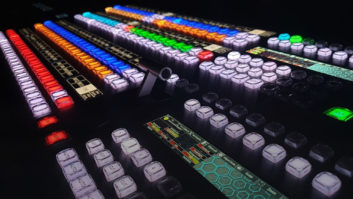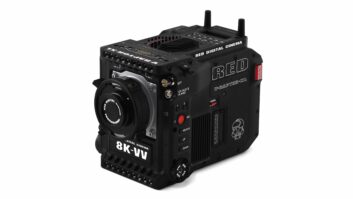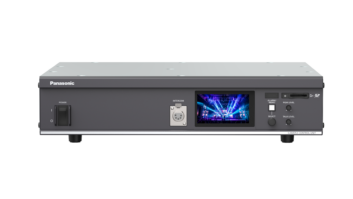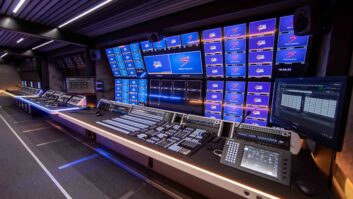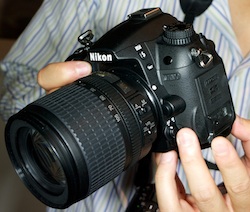
The Nikon D7000 sits above its popular D90 (which was the first DSLR to offer 720p video) but below the D300s, and is a considerable upgrade from its recently launched first full HD DSLR, the entry-level D3100.
It records 1920×1080 @ 24fps (but not at 25fps) or 1280×720 @ 24, 25 and 30fps using MPEG4 AVC/H.264 recording in the .mov file format. In our limited tests on a pre-production model we shot several video clips, and found the bitrates varying from 23.96Mbps to 27.82Mbps – a higher rate than on the D3100 (which averaged about 20Mbps), however, these were shot indoors, in an artificially lit room in fairly poor light (at ISO 1600), which would probably push the compression a bit higher than the better lit conditions we tried the D3100 out in. That said the picture quality was good, with accurate colour rendition.
At 1600 ISO, there was noticeable grain, but it wasn’t objectionable – although a JPEG taken at the same setting exhibited less grain. As you’d expect with a CMOS sensor, there was skew caused by the rolling shutter, but this seemed to be a lot less than was evident on the D3100, and barely noticeable at any sensible panning speed (and got lost in motion blur if panned much faster).
Features include: stereo microphone mini jack input; 3-inch TFT LCD monitor, with 921k-dot resolution; video clip trimming; Mini HDMI output; simple, direct access, Live View and video recording control; tone and colour controls that let you set the look and mood of your pictures and movies before you shoot; good low-light performance (100-6400 ISO, extendable up to 25600); twin SD memory card slots (SDHC and SDXC) allowing for extra storage capacity; a new image-processing engine, Expeed 2, delivering higher image quality and faster processing (than the D90); a new 16.2-megapixel APS-C CMOS image sensor; a rugged, part-magnesium body with dust and moisture sealing; glass Pentaprism Viewfinder with 100% frame coverage and 0.94x magnification; a newly developed auto focus system featuring 39 focus points, including 9 cross-type sensors in the centre; AF-F during video recording, giving continuous focus (although some of the motor noise was recorded on the built-in microphone in our limited testing); face detection with contrast AF that is claimed to be is faster than previously; the ability to detect up to 35 faces within about 0.08 seconds, even if subjects are not directly looking at the camera; subject tracking to keep moving subjects in focus; and a new 2,016 pixel RGB metering sensor.
The camera weighs 780g including the battery, and list price is £1099.99 / €1,303 (Body only) or £1299.99 / €1,540 (D7000 + 18-105mm VR kit lens bundle). It is dues to start shipping on October 29th.
Pentax K-5
The new Pentax K-5 will be its first 1920×1080 HD camera and has some significant advantages, but isn’t as fully developed as a video camera as some of its rivals.
The benefits include its compact, very rugged, weather/dust sealed body, and built-in shake reduction – which smoothes out any movement without the need to buy more expensive image stabilised lenses (it will work with a huge range of old K-mount lenses, or via an adaptor even older M42 screw mount lenses). There are also weather-resistant lenses on offer, including some of the kit lenses (such as the new 18-135mm WR model).
It apparently uses a Sony CMOS sensor very similar to the one found in the D700, but with Pentax’s own digital image processor, which initial pre-production tests indicate may exhibit slightly less evident noise at high ISO. It also records HD at 25 frames per second (as well as 1280×720 at 25 or 30fps). Any of the K-5’s many custom image modes and digital filters can be applied to the video (although this can affect the framerate if it is particularly processor intensive).
Its magnesium and stainless steel body has 77 seals to make it dustproof, weather-resistant and cold-resistant (at least as low as -10°C). It has a 3.0-inch wide-view LCD monitor with 921,000 dots.
However, it doesn’t seem to have many, if any, manual controls available during video recording, or auto focus during recording, although the pre-production models shown at Photokina recently were running an early version of the firmware. Also, it records Motion Jpeg files (although the bitrate hasn’t been revealed yet). It is expected to ship later this month and prices should be close to, perhaps a little above the D7000.
Panasonic GH2
The new Panasonic Lumix GH2 Micro Four Thirds interchangeable lens camera offers 1080p video, 16-megapixel stills, and can also take 3D stills with a new twin-optic lens (which may be useful if it can do timelapse 3D).
It isn’t a reflex camera (it doesn’t have a mirror), so it is smaller than a DSLR. It has a useful 3-inch articulated touchscreen 460,000-pixel LCD display (which can be used to pull focus in video mode by touching where you want it to focus, and seems to be very responsive – it also does subject tracking). It also has Mini HDMI output, mini-jack audio input (with manual audio control), and records to SD/SDHC/SDXC memory cards. It can also take 14MP 16:9 stills while recording video.
The GH1 could capture 1080i HD AVCHD video, but only at 17Mbps (unless it was hacked, which Panasonic prevented with updated firmware), and had a sensor output of 25/24fps. The GH2 records at up to 24Mbps, and has faster readout from the sensor (at 50/60fps). It apparently outputs 50/60i at 17Mbps or 24p at 24Mbps, but isn’t going to do 25p at 24Mbps (hopefully that may change by the time it ships or could be a firmware upgrade).
It is expected to ship early December, and retailers are quoting initial prices at less than £900 including 14-42mm lens (the sensor has a 2x crop factor). It will probably interest anyone intending to buy Panasonic’s AF100/AF101 Micro Four Thirds camcorder, as it could be a useful B camera.
